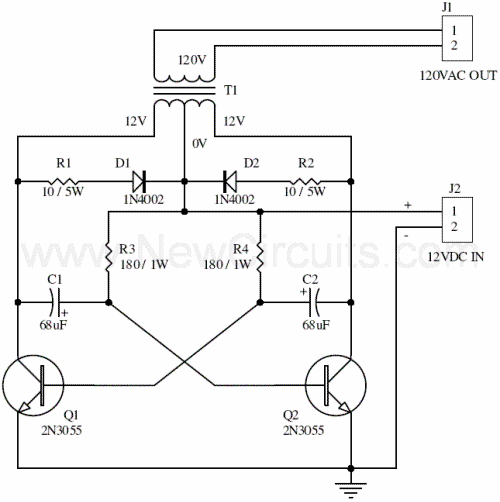12V Inverter
This inverter will sufficiently power any of your 115VAC (or 220VAC)small appliances. T1 choice of amperage is yours to make, but if you can salvage a heavy-duty unit from somewhere, use it. The least expensive method to get a larger transformer would be to remove the old 2000v primary and then re-wind an old microwave transformer. Most of these transformers are rated 1KW or better. Your local TV or Electronics repair shop may have one or dig one up from the dumpster. Just in case you don't know, micro-wave transformers can keep their charge (via the connected electronics) for a long time, so be careful!

R1 and R2 are 10 ohm, wire-wound, and at least 5 watts. Wattage/cooling should be increased accordingly if you decide to beef up the output. For D1 and D2 you can use any power diode like the 1N4002 to 1N4005.
If you live in Europe, Australia, or any other country with a 220VAC system, the only different is the transformer. This particular circuit can be constructed to handle up to 1 KiloWatt (1000 watt). If there is enough interest, I can modify this circuit to include a crow-bar circuit, battery backup, or more output in watts, or everything. The power output is determined by transformer T1, and power transistors Q1 & Q2. Assume a transformer of about 15A and the chosen transistors of 2N3055 (15A) type, the inverter can supply about 300 watts with the parts shown. If you are good with electronics all you have to do is replace the 2N3055's and T1 accordingly for more output. It is imperative to mount Q1 and Q2 on large coolribs. If you intend to beef everything up with a couple kilowatts a standard (5") cooling fan will also be required. If this is the case, the 2N3771 power transistor is a good choice at 30Amps. NTE's replacement, NTE181, is an improved version of the 2N3771 and carries 90volts instead of the 40 volts and can dissipate 200W instead of 2N3771's 150W.
It is mandatory to include at least one suitable fuse and enclose this project in the correct casing. To be really safe you may want to include a primary and secundary fuse for your own protection. You are dealing with 120VAC or 220VAC at respectible amperage so be careful. The powercord also needs to be secured to prevent accidents.
The 68uF Tantalum capacitors were chosen for their endurance. Normal electrolytic capacitors would overheat and explode. Somesort of cooling fan inside the project case may be a good choice.
Title: 12V Inverter
electronic circuit
Source: unknown
Published on: 2005-08-27
Reads: 3075
Print version: ![]()
Other electronic circuits and schematics from Power
-
Nicad Battery Charger
-
120 VAC Lamp Dimmer
-
2W Switching Power Supply
-
Ni-Cd Battery Auto Charger
-
12 Volt 30 Amp PSU
-
TTL Power Supply with вАШCrowbarвАЩ protection
-
Power-Off Time Delay Relay
-
AC Current Monitor
-
Voltage Inverter
-
6V to 12V Converter
